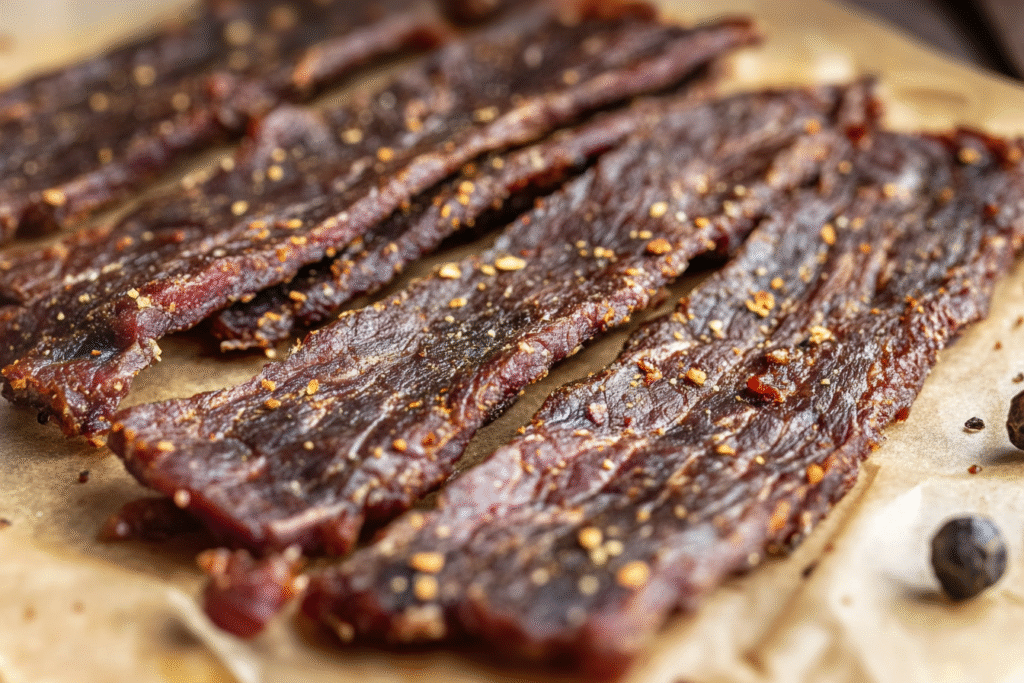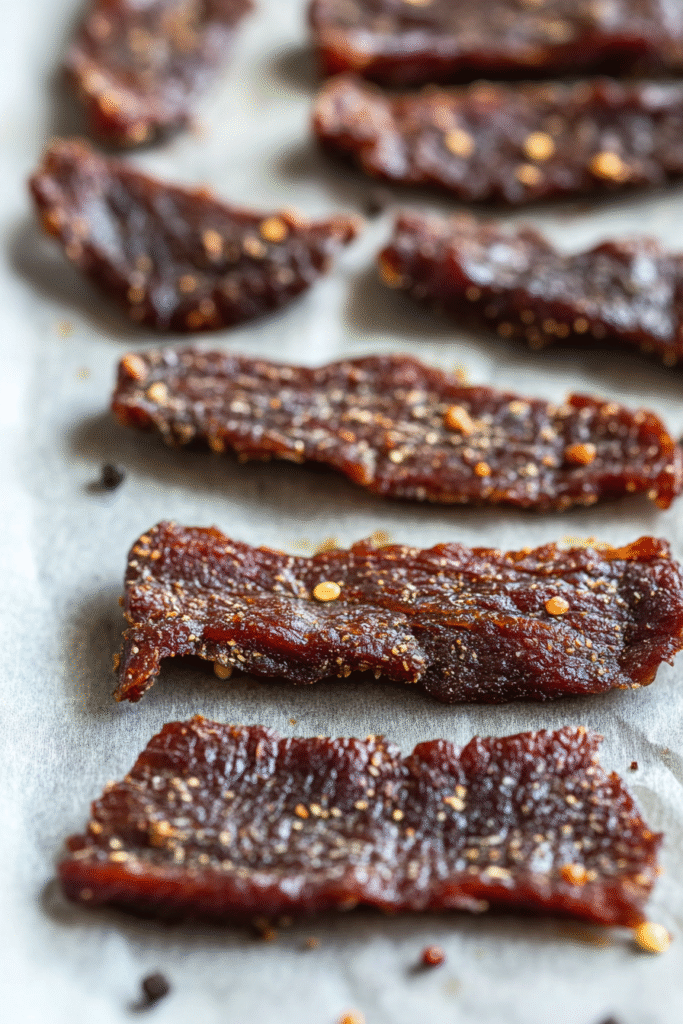Beef jerky is one of the most satisfying snacks—portable, protein-packed, and intensely flavorful. Whether you’re looking for a high-energy hiking snack, something to stash in your gym bag, or just a healthier alternative to store-bought options, making beef jerky at home is easier than you might think.
This Homemade Beef Jerky Recipe is designed to guide you through every step, from selecting the right cut of beef to marinating, drying, and storing your jerky properly. Along the way, I’ll walk you through common mistakes, essential techniques, and flavor variations so you can confidently make your own perfect batch every time.
Why Homemade Beef Jerky is Worth It (And Common Pitfalls to Avoid)
Store-bought beef jerky can be loaded with preservatives, sugar, and artificial flavors—not to mention the price per ounce is usually steep. Making your own not only saves money but gives you full control over the flavor, texture, salt level, and spice.
However, there are a few challenges to homemade jerky:
- Wrong cut of beef: Using fatty cuts can lead to spoilage because fat doesn’t dehydrate well.
- Inconsistent slicing: Uneven cuts can cause some pieces to over-dry while others stay too soft.
- Improper drying: Can result in jerky that spoils quickly or doesn’t develop the right chew.
This recipe addresses all of these potential pitfalls by focusing on:
- Proper beef selection
- Freezing tips for clean, uniform slicing
- The right marinating time
- Safe drying techniques using an oven or dehydrator

Selecting the Right Beef for Jerky: Lean is Best
Choosing the right cut of beef is the most important step in making jerky that’s flavorful and long-lasting.
Best Cuts for Beef Jerky:
- Eye of Round: Lean, affordable, and easy to slice.
- Top Round (London Broil): Another lean and widely available cut.
- Bottom Round: Slightly tougher but still great for jerky.
- Sirloin Tip: Lean and tender, though a bit more expensive.
- Flank Steak: Can work but often has more visible fat to trim.
Avoid:
- Marbled cuts like ribeye or chuck. Fat doesn’t dehydrate well and can turn rancid, shortening shelf life.
Pro Tip: Freeze the beef for 30-60 minutes before slicing. This firms it up and makes it easier to cut into even strips.
Slicing Techniques: The Key to Great Texture
- Against the Grain: Shorter muscle fibers for more tender jerky.
- With the Grain: Longer fibers create a chewier, more traditional jerky texture.
Thickness matters:
- ¼ inch thick strips are ideal. Thinner slices will become brittle, thicker slices may not dry properly.

Equipment Essentials for Homemade Jerky
- Sharp knife: Critical for clean, even slices.
- Oven with a wire rack or food dehydrator: Both methods work well.
- Large zip-top bags or shallow dishes: For marinating the beef.
- Baking sheets and parchment paper: For catching drips in the oven.
If you plan to make jerky regularly, investing in a dehydrator will save time and provide more consistent results.
Preparation Strategy: Timing is Everything
Beef jerky is not a fast recipe, but it’s mostly inactive time. Here’s a typical timeline:
- Beef slicing: 15-20 minutes (freezing the beef first speeds this up)
- Marinating time: Minimum 6 hours, ideally overnight
- Drying time: 4-6 hours in a dehydrator or oven at low temperature
Start this project the day before you want to enjoy your jerky for best flavor.
Flavor Variations and Customizations
Beef jerky is endlessly customizable. Start with this basic marinade, then try these flavor profiles:
- Spicy: Add crushed red pepper flakes, cayenne, or hot sauce.
- Sweet: Increase brown sugar or add a touch of honey.
- Teriyaki: Use soy sauce, brown sugar, and ginger.
- Smoky: Add liquid smoke for deep barbecue flavor.
You can also swap soy sauce for coconut aminos to make the jerky lower in sodium and gluten-free.
Common Jerky-Making Mistakes and How to Fix Them
- Beef is too tough: You may have sliced too thick or dried it too long. Thinner cuts and careful monitoring help.
- Jerky spoils quickly: Fat wasn’t trimmed properly, or the jerky wasn’t dried long enough.
- Jerky is too brittle: Slices were too thin or dried at too high a temperature.
- Jerky lacks flavor: Marinate longer or adjust the marinade ingredients to suit your taste.
Storage and Shelf Life
- Short-term storage: Store in an airtight container or zip-top bag at room temperature for up to 1 week.
- Refrigeration: Extends shelf life to 2-3 weeks.
- Freezing: Jerky can be frozen for up to 6 months. Thaw at room temperature before eating.
For longer shelf life at room temperature, you can use curing salts (optional) or vacuum-seal the jerky.
Homemade Beef Jerky Recipe
Ingredients
For the Beef:
- 2 pounds lean beef (eye of round, top round, or sirloin tip), trimmed of fat
Marinade:
- ½ cup soy sauce
- ¼ cup Worcestershire sauce
- 2 tablespoons brown sugar
- 1 teaspoon black pepper
- 1 teaspoon garlic powder
- 1 teaspoon onion powder
- 1 teaspoon smoked paprika (optional)
- ½ teaspoon red pepper flakes (optional for heat)
Step-by-Step Instructions
Step 1: Prepare the Beef
- Partially freeze the beef for about 30-60 minutes to firm it up.
- Slice beef into ¼ inch thick strips, cutting either with or against the grain based on your preferred chew.
- Trim off any remaining visible fat.
Step 2: Make the Marinade
- In a large bowl, whisk together soy sauce, Worcestershire sauce, brown sugar, pepper, garlic powder, onion powder, smoked paprika, and red pepper flakes.
Step 3: Marinate the Beef
- Place beef strips in a zip-top bag or shallow dish.
- Pour marinade over the beef, ensuring all pieces are well coated.
- Seal and refrigerate for at least 6 hours, ideally overnight, flipping occasionally to ensure even marination.
Step 4: Prepare for Drying
- Preheat oven to 170°F (75°C) or use a food dehydrator per manufacturer’s instructions.
- Line baking sheets with parchment paper and place wire racks on top.
- Arrange beef strips in a single layer on the racks, leaving space between each piece for proper air circulation.
Step 5: Dry the Jerky
- Bake in the oven for 4-6 hours, flipping once halfway through. Leave the oven door slightly ajar (using a wooden spoon to prop it open) to allow moisture to escape.
- In a dehydrator, dry at 160°F (71°C) for about 4-5 hours until the jerky is firm and bends without breaking.
Step 6: Cool and Store
- Let jerky cool completely.
- Store in an airtight container, zip-top bag, or vacuum-sealed bag.
How to Check for Doneness
Properly dried jerky should:
- Be firm but still slightly pliable.
- Bend without snapping.
- Show no visible moisture when torn.
If it breaks easily, it’s over-dried. If it feels soft or sticky, it needs more time.
Serving Suggestions
- Snack time: Perfect as an on-the-go high-protein snack.
- Trail mix boost: Combine with nuts and dried fruit for a portable energy mix.
- Lunch box addition: Great for school or work lunches.
- Charcuterie board: Add to a savory spread alongside cheeses and pickles.
Jerky Methods Comparison: Oven vs. Dehydrator vs. Smoker
| Feature | Oven | Dehydrator | Smoker |
|---|---|---|---|
| Temperature Control | Moderate | Precise | Variable |
| Drying Time | 4-6 hours | 4-5 hours | 3-4 hours |
| Flavor | Basic | Concentrated | Smoky |
| Best For | Occasional batches | Frequent jerky making | Deep smoky flavor |
FAQs and Troubleshooting
Can I use ground beef for jerky?
Yes, but you’ll need a jerky gun to form strips. Ground beef jerky requires different drying guidelines.
How long should I marinate the beef?
At least 6 hours, but overnight is ideal for maximum flavor absorption.
Can I make it gluten-free?
Yes. Use gluten-free soy sauce or coconut aminos.
How do I make it sweeter or spicier?
Increase the brown sugar for sweetness or add more red pepper flakes or hot sauce for spice.
Why is my jerky too brittle?
It was either sliced too thin, dried too long, or dried at too high a temperature.
Final Thoughts
Making Homemade Beef Jerky is a rewarding process that gives you complete control over flavor, texture, and ingredients. It’s a snack you can customize endlessly—from sweet and smoky to spicy and bold—and it’s surprisingly simple once you master the slicing, marinating, and drying techniques.
Whether you’re packing it for hiking, using it as a protein-rich snack between meals, or gifting it to friends and family, homemade beef jerky is a satisfying project with delicious results. Once you’ve tried making your own, you might never go back to the store-bought version again.
